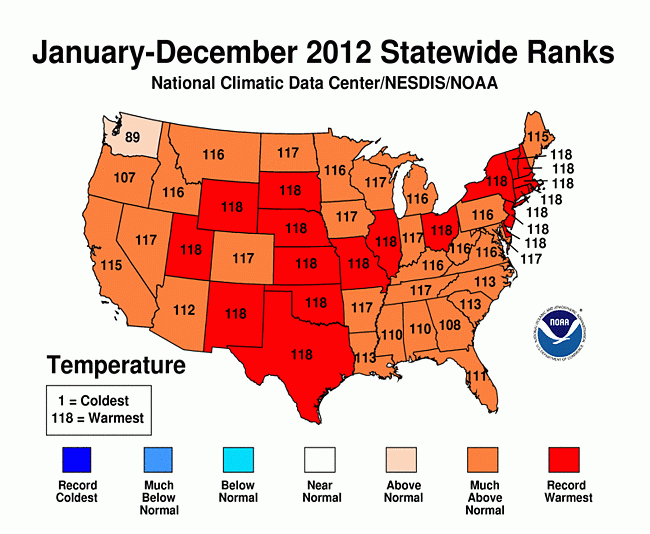2012 Hottest Year On Record For US, Also Ranked 2nd On Extreme Weather

2012 was the warmest year on record in the United States, according to the National Oceanic and Atmospheric Administration.
The average temperature in the lower 48 states over the past year was 55.3 degrees Fahrenheit – 3.2 degrees above the 20th-century average, and a degree higher than the previous record, set in 1998.
“It is extremely rare for an area the size of the U.S. to break an annual average temperature record by such a large margin,” Weather Underground meteorologist Jeff Masters wrote on Tuesday. “Nineteen states, stretching from Utah to Massachusetts, had annual temperatures which were record warm.”
2012 was also the 15th driest year on record, with an average of 26.57 inches of precipitation across the country.
Dry conditions reigned last summer, with drought gripping 61 percent of America at one point in July. This proved to be the ideal conditions for wildfires, which scorched 9.2 million acres in the Western U.S. last year, the third-highest area of wildfire-destroyed land on record.
NOAA’s Climate Extremes Index also ranked 2012 as the second-most extreme year for weather. The CEI examines how much of the continental U.S. is experiencing extreme temperatures, rain, snow and drought conditions. The CEI for 2012 was 39 percent, about double the average level of 20 percent, according to Masters.
If Hurricane Sandy had been factored into the CEI for 2012, it would have been even higher.
“Since Hurricane Sandy was not considered a hurricane when it came ashore, that storm did not contribute to the 2012 CEI,” Masters wrote. “If one plots up the CEI without using the tropical storm and hurricane indicator, 2012 is the most extreme year on record, beating out 1998, 46% to 42%.”
America isn’t the only country feeling the heat. Australia is preparing for temperatures to break 52 degrees Celsius – that’s more than 125 degrees Fahrenheit – for the first time, more than outstripping the previous record of 50.7 degrees Celsius set in 1960. The record for hottest average day across Australia was already broken this week, with a nationwide mean temperature of 104 degrees Fahrenheit.
The roasting temperatures have forced Australia’s weather bureau to add a new color to the top of its temperature gradient – a bright and radiant purple.
"What makes this event quite exceptional is how widespread and intense it's been," Aaron Coutts-Smith, climate services manager for Australia’s Bureau of Meteorology, told the Guardian. "We have been breaking records across all states and territories in Australia over the course of the event so far."
When you put 2012’s record high temperatures with other signs like the record amount of extreme weather and this year’s record loss of Arctic sea ice, or the fact that if you’re under age 27, you’ve never experienced a month that was colder than average, it’s hard to ignore the looming threat of climate change.
Todd Sanford, a climate scientist for the Union of Concerned Scientists, noted in an op-ed for McClatchy-Tribune Information Services that the U.S. and other countries have pledged to limit climate warming to 3.6 degrees Fahrenheit or less above pre-industrial levels. But there are currently no policies that will help humanity feasibly meet that goal, Sanford says.
“Instead, we’re on track to experience more than 7 degrees of warming by the end of the century,” he wrote. “That wouldn’t be a ‘new normal.’ That would be a different planet.”
© Copyright IBTimes 2025. All rights reserved.





















